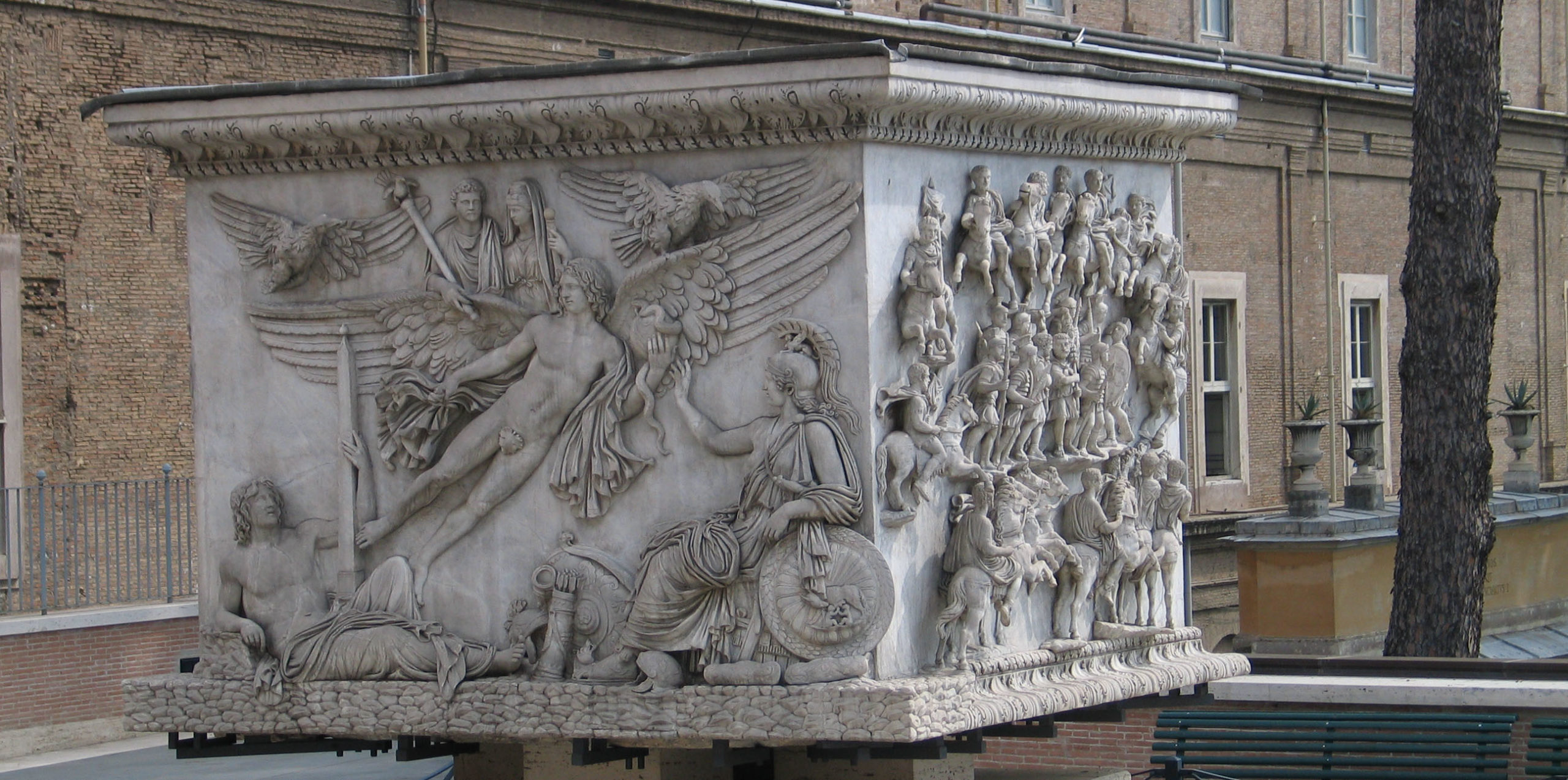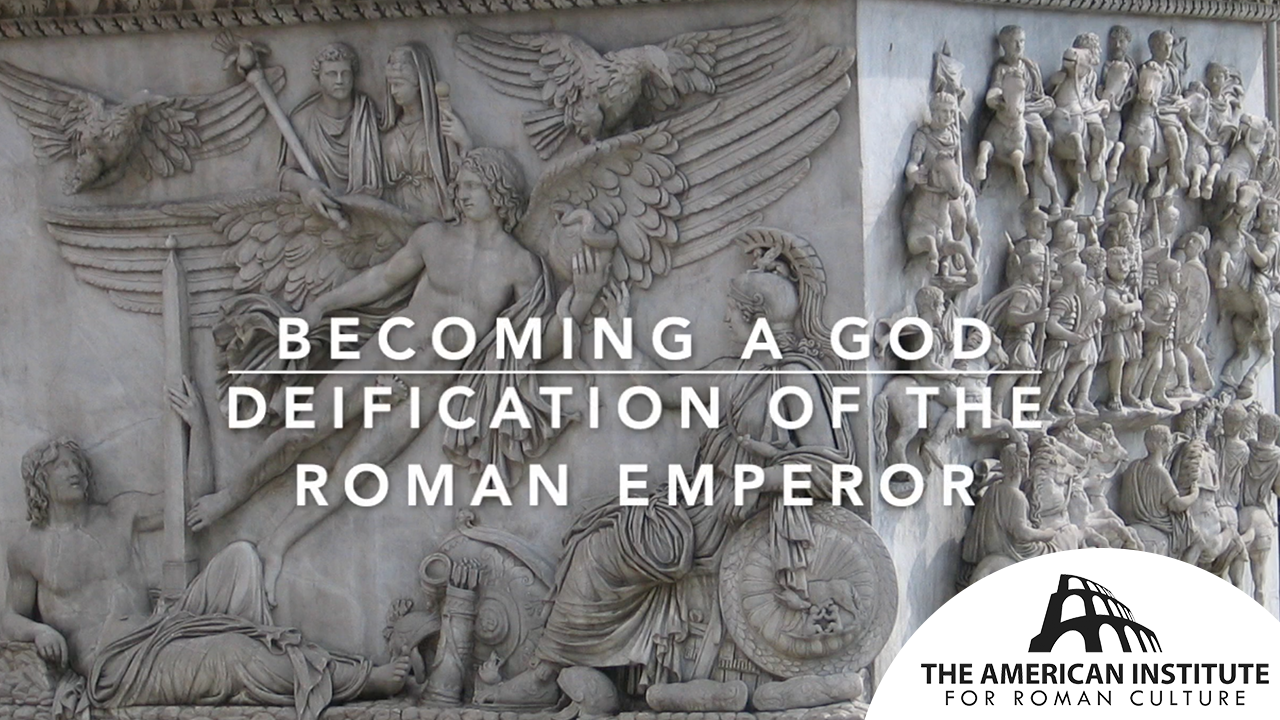Watch the online seminar hosted by Darius Arya here:
The process of deifying Roman rulers came from Eastern cultures, as the Empire expanded and conquered those regions. The Greeks and the Egyptians customarily worshiped their rulers as gods, including the pharaohs and Alexander the Great, even while they were still alive.
There is considerable evidence of the worship and deification of Roman rulers. Recently archeologists discovered a tomb that may be connected to the cult of Romulus, the legendary founder and first king of Rome. In 2020, the 6th century BCE sarcophagus was found under an ancient temple in the Roman Forum. Though the debate around the existence or myth of Romulus in ongoing, the archeologists involved in this discovery believe the tomb is a “place of memory in the heart of the city” where the cult of Romulus was celebrated. Plutarch indicated in his text Lives of the Noble Greeks and Romans, that the god Quirinus is the deified representation of Romulus.
The first undisputed Roman ruler to be deified was Julius Cesar. He began to be worshiped while he was alive due to his military successes. Statues were erected and games were held in his honor. Scholars believe that the exaggerated praise may have displeased his enemies, ultimately leading to his assassination. His death elevated him to the position of a god, and the common people of Rome adored him as such, with the Senate officially granting him the title of Divus.
His successor and adoptive son, Augustus, became the first Roman Emperor in 27 BCE. He inherited the divinity of Cesar and was also worshiped during his lifetime, though similar to Cesar, he denied much of the praise he received. The first version of the Pantheon was completed in the year 25 BCE by Agrippa, a trusted friend of Augustus. It is believed that the structure was very similar to the one still standing today, and was filled with statues of all of the gods, in the niches of the rotunda, including one of Divus Iulus (divine Julius Cesar).
Statues of Agrippa and Augustus were placed outside on the porch. Though they were both alive when the Pantheon was inaugurated, it is likely that they sought to guarantee their place inside among the other gods in the afterlife. Reinforcing this theory, the entrance of the Pantheon is oriented towards the north. Walking out to the porch, one could immediately see the monumental Mausoleum of Augustus, completed earlier in 28 CE. Dying and being buried were fundamental steps in the deification process and the proximity of these two constructions was strategically planned.
The chain of events following the death and building up to the deification of a ruler was strictly organized though adapted many times. It included a formal decree by the Senate, a public imperial funeral, the consecration of the next emperor, and finally a symbolic apotheosis of the dead by releasing an eagle from their funeral pyre to represent their ascension to the heavens. There are some marble reliefs representing the apotheosis of different public figures. The artistic style of these representations changes through time, though the presence of the eagle carrying the newly proclaimed divinity is a consistent iconographic theme.
Bibliography
- Burton, H. F. (1912). The Worship of the Roman Emperors. The Biblical World, 40(2), 80–91. http://www.jstor.org/stable/3141986
- Chalupa, A. (2007). How Did Roman Emperors Become Gods? Various Concepts of Imperial Apotheosis. Anodos: Studies of the Ancient World. 6-7/2006-2007, 201-207 https://www.academia.edu/2577051/How_Did_Roman_Emperors_Become_Gods_Various_Concepts_of_Imperial_Apotheosis
- Scott, K. (1925). The Identification of Augustus with Romulus-Quirinus. Transactions and Proceedings of the American Philological Association, 56, 82–105. https://doi.org/10.2307/282886
- Strong, E. (1915). Apotheosis and after life: Three lectures on certain phases of art and religion in the Roman empire. London: Constable, 90-2.
- Turcan, R. (1996). The Cults of the Roman Empire. Oxford: Blackwell.
- News article “Romulus mystery: Experts divided on ‘tomb of Rome’s founding father’” – https://www.bbc.com/news/world-europe-51587892
Read More
Out of Suetonius’ 12 Caesars, 5 were deified – Julius, Augustus, Claudius, Vespasian and Titus. Upon deification emperors would have had a temple built by their successor (though Nero never finished Claudius’ temple, that was down to Vespasian). Julius, Augustus, Vespasian and Titus had theirs in the Forum Romanum, with the two Flavians sharing one, and Claudius’ was on the Caelian Hill. The only one without visible remains today is the Temple to the Divine Augustus. A trend here, and continued through until the Severan period is that only emperors who history has seen as “good” have been deified, and said deification may be a part of why history has remembered them as “good”. All of the emperors in the Nerva-Antonine dynasty were deified, including Commodus. This breaks the ‘only good emperors get deified’ trend, though it was done by Septimius Severus to make himself popular with the remaining family of Marcus Aurelius. It is important to note that Antoninus Pius had to fight for Hadrian to be deified, which may have been a reason behind the Pius part of his name. Part of the temple to the Divine Hadrian stands in Piazza di Pieta today, Antoninus’ Temple is in the Forum Romanum, and it is thought that Trajan’s was at the end of his Imperial Forum. It is not known where the temples to Nerva, Marcus Aurelius, or Lucius Verus were. Though perhaps in the same area of Hadrian’s in the Campus Martius would be a good estimate. There are several surviving representations of the process of deification, one depicts Sabina, wife of Hadrian being deified, and comes from the Arch of Portugal, Titus can be seen on the back of an eagle in the centre of his arch’s vault in the Forum Romanum, and the base of the Column of Antoninus Pius in the Vatican Museums depicts Antoninus and Faustina being carried off to heaven by a winged Genius. In the earlier imperial period it would take ratification by the Senate to have an emperor deified, though as time goes on it seems as if emperors could deify their predecessors without approval of the Senate, or force the Senate to accept that deification. The process of Deification would last until Constantine the Great.
This content is brought to you by The American Institute for Roman Culture, a 501(C)3 US Non-Profit Organization.
Please support our mission to aid learning and understanding of ancient Rome through free-to-access content by donating today.
Cite This Page
Cite this page as: Darius Arya, The American Institute for Roman Culture, “Becoming a God; the Deification of the Roman Emperor” Ancient Rome Live. Last modified 03/22/2022. https://ancientromelive.org/becoming-a-god-the-deification-of-the-roman-emperor/
License
Created by The American Institute of Roman Culture, published on 04/06/2020 under the following license: Creative Commons: Attribution-NonCommercial-ShareAlike. This license lets others remix, tweak, and build upon this content non-commercially, as long as they credit the author and license their new creations under the identical terms. Please note that content linked from this page may have different licensing terms.



